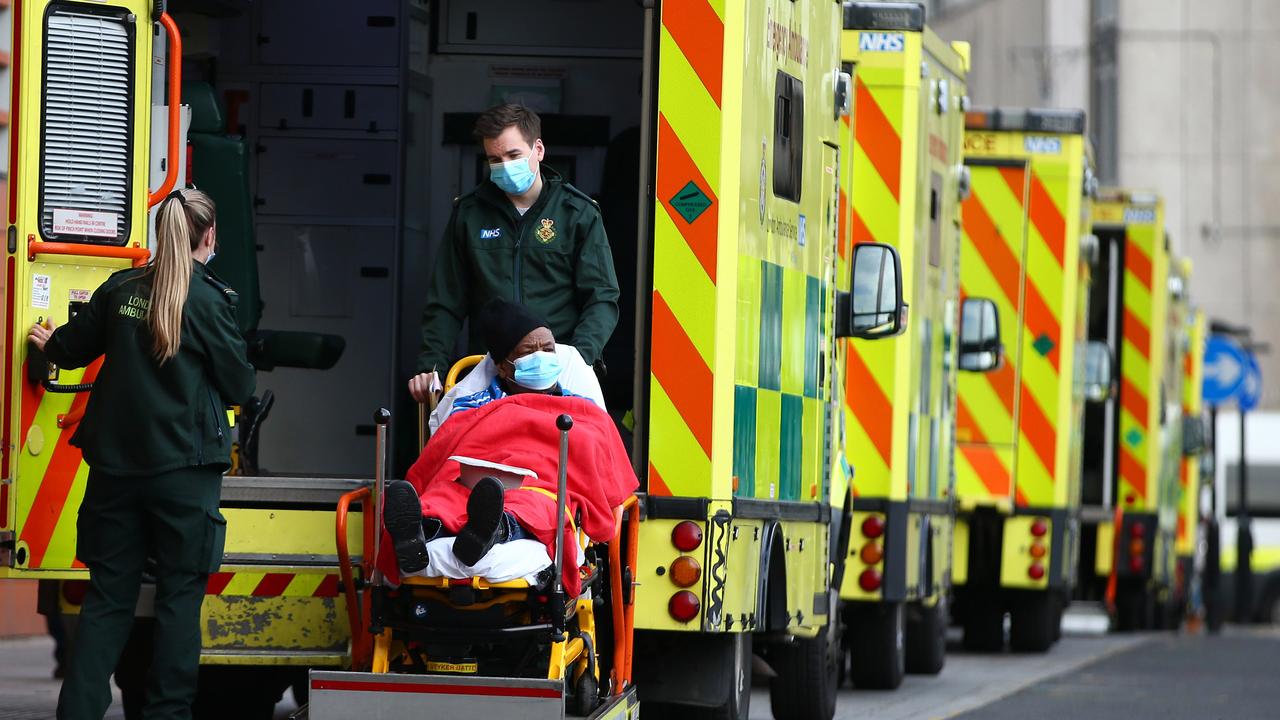
It’s a disturbing sight now occurring outside major British hospitals – queues of ambulances filled with patients unable to access the wards amid a surge in coronavirus cases as a new, more contagious, strain sweeps through the country.
Britain’s new peak in cases has been labelled an emerging “catastrophe”.
The strain is not more deadly than the previous COVID-19 strains, but it’s claimed it could be up to 70 per cent more transmissible. And the more people who contract the virus, the more people will become seriously ill with it.
Yesterday, heath officials in England, which accounts for around 80 per cent of the UK population, reported 50,000 new COVID-19 cases and almost 1000 deaths. That’s 10 times higher than the peak in April during the first wave.
While testing rates in the UK were significantly lower than now, so many cases were missed, yesterday’s figure was the highest since testing became more widely available. Cases in other parts of the UK, such as Scotland and Wales, are also on the rise.
Deaths are nearing the same levels as seen during the April peak.
RELATED: All the latest coronavirus updates
“We are entering a very dangerous new phase of the pandemic, and we’re going to need decisive early national action to prevent a catastrophe in January and February,” Andrew Hayward, a professor of infectious disease epidemiology at London’s University College London, told the BBC.
Pictures have now begun to emerge of ambulances parked outside hospitals, with patients – many of them with the virus – being treated in the vehicle rather than on the ward.
Earlier this week, a queue of ambulances was outside the Royal London Hospital, one of the capital’s largest.
“We are facing significant pressure from high COVID-19 admission rates and non-COVID winter demands,” a spokesman of Barts National Health Service (NHS) Trust, which runs the hospital, told the BBC.
“Due to the increase in demand and our robust infection control measures, we have been treating some patients who arrive at our emergency departments from their ambulance until a cubicle becomes available.”
The need to isolate those with coronavirus from other patients is another factor putting strain on hospitals.
RELATED: New strain of COVID-19 brought into Australia from UK
RELATED: Fresh COVID concerns for eight Sydney suburbs
‘HOSPITALS AT BREAKING POINT’
Figures from the NHS, Britain’s public health provider, have shown some London hospitals have filled up more than 99 per cent of their bed capacity.
On Wednesday, more than 15 ambulances queued outside the Queen Elizabeth University Hospital in the UK’s second largest city of Birmingham.
Local Birmingham paper the Express and Star reported that palliative care doctor Rachel Clarke tweeted a photo, taken by registrar Punith Kempegowda, with the caption noting there was a “sick patient inside every one” of the vehicles.
“This is the reality of COVID – hospitals at breaking point,” she added.
Vast areas of Britain have now been placed into so-called “tier four” measures. These are the highest COVID-19 restrictions which effectively confine people to their homes aside from food shopping and other essential activity.
In England, only Yorkshire and the area round Liverpool is not within this top tier of restrictions.
On Wednesday, the UK approved the Oxford University-AstraZeneca vaccine for use.
Half a million doses will be available from next week, with up to 100 million on order.
The vaccine will be given in two doses, an initial jab followed by a second shot up to three months later.
Unpublished data has claimed the Oxford vaccine is 70 per cent effective after just a single dose with that figure rising after the subsequent jab.
While it may be a touch less effective than rival vaccinations, the Oxford vaccine has the advantage of being cheaper to produce and far easier to transport.
Health and Fitness | news.com.au — Australia’s leading news site
